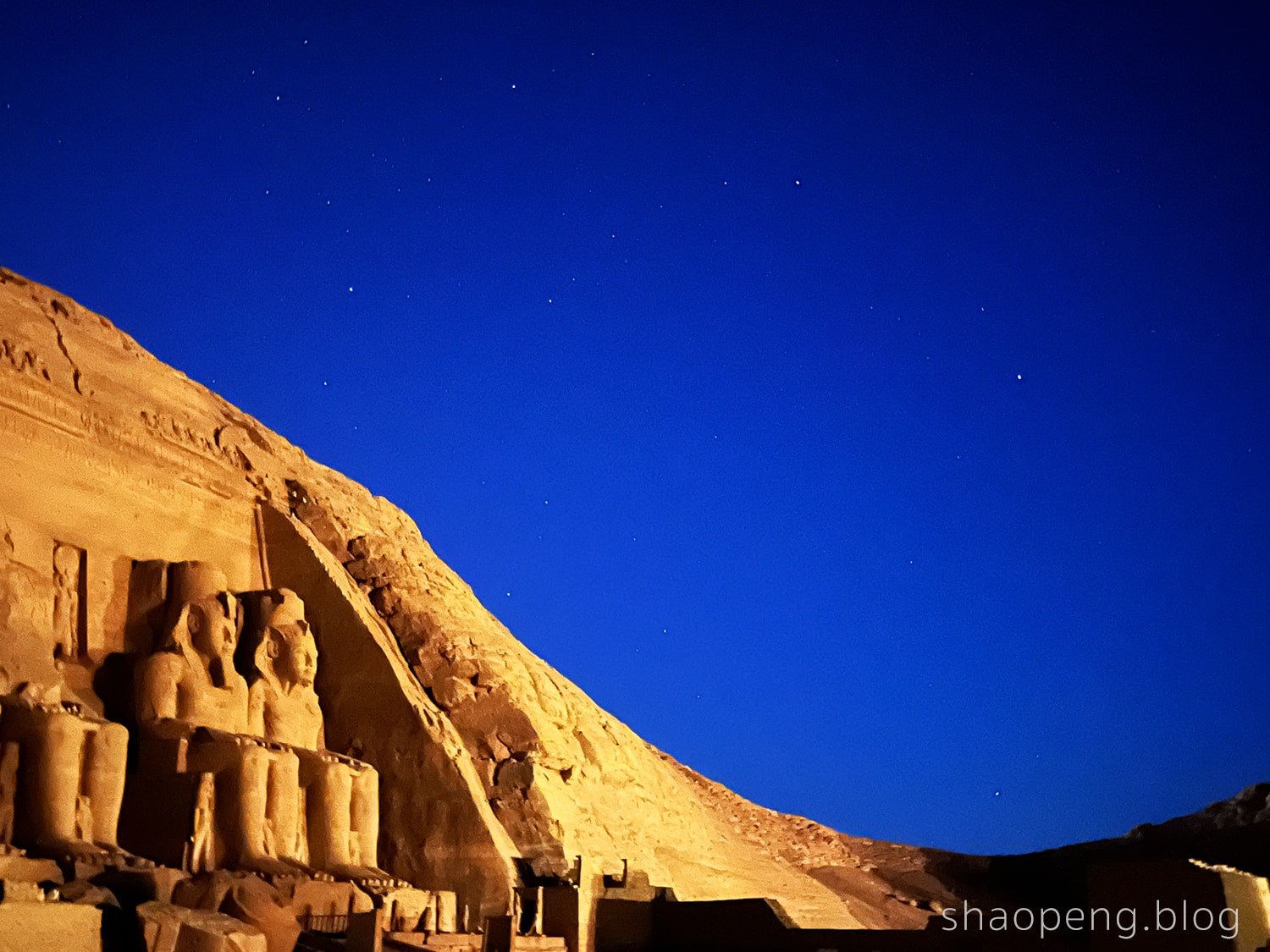Wander in Egypt: Abu Simbel from Dusk to Dawn
Sense of Wander: ★★★★★
Abu Simbel emanates a radiant glow in the dark after the Sound & Light show
ASWAN, Egypt — Alongside the Great Pyramids of Giza and the Valley of the Kings, Abu Simbel stands out as one of Egypt’s most popular sought-after destinations, attracting visitors from different parts of the world. This ancient monument holds a special place in my heart and has left a lasting impression on me.
Located southwest of Aswan, Abu Simbel (أبو سمبل) marks the southernmost point — closest to the Sudanese border — of my travels in Egypt. The site features two enormous temples meticulously carved out of sandstone cliffs between 1274 and 1244 BC. The Great Temple's facade, in particular, is adorned with imposing colossi sculpted from living rock that continues to evoke the grandeur of King Ramesses II's empire (reigned 1279-1213 BC) to this day.
Swiss explorer John Lewis Burckhardt is credited with the discovery of Abu Simbel. In 1813, Burckhardt was reportedly led to the site by a local boy named Abu Simbel, which led to the site being named after him.
Italian archaeologist Giovanni Belzoni wrote of his astonishment at the state of the entrance to Abu Simbel in the early 19th century, describing how sand from the north side had accumulated and buried two-thirds of the temple's entrance. “On my approaching this temple, the hope I had formed of opening its entrance vanished at once; for the amazing accumulation of sand was such, that it appeared an impossibility ever to reach the door,” exclaimed Belzoni.
The fact that the temple had survived being buried in sand for three thousand years before being uncovered and revealed to the world is truly astounding. However, in the mid-20th century, this site of great historical significance faced another threat.
The construction of a new dam at Aswan by the Egyptian government in 1956 posed a threat to ancient sites and monuments along the Nubian stretch of the Nile, as rising waters began to accumulate. To rescue these precious relics, UNESCO launched an international campaign in 1960 that involved dismantling the two temples at Abu Simbel. The temples were cut into blocks and reassembled on a nearby site about 60 meters above the original water level.
Abu Simbel under the Stars
Abu Simbel under the starry skies.
Unlike most travel guides that showcase photos of great monuments basking in daylight, my first glimpse of Abu Simbel took place at night.
As I made my way through the security check, I set out on foot along the Nile’s edge towards the Great Temple. The path was dimly lit, but everyone seemed to know the way.
A gentle breeze accompanied me as I descended down a gradual slope, and as I looked up, I was greeted by a sky draped with a carpet of twinkling stars, each one resembling a cosmic eye that had watched over this ancient Egyptian site for millennia.
After a 10-minute walk, the sight of Abu Simbel finally came into view. At first, the silhouette of the monument was barely visible in the dark. Shortly after, the light show began, enveloping the rock-cut temples with animated videos and illuminated displays of light.
The Aswan Sound and Light Show transports its audience to the time of the pharaohs, with a narration that recounts the story of King Ramesses II, under whose reign Abu Simbel was constructed. The captivating music enhanced the immersive experience, but I couldn't help but notice that the quality of the projections, particularly in terms of color and clarity, left room for improvement.
Deep down, I felt disheartened to see how this archaeological site had been turned into a commercial spectacle. I couldn't help but imagine Abu Simbel in its original state, unencumbered by the overwhelming sound and light projections. It made me wonder, though briefly, whether it might have been better for Abu Simbel to remain buried beneath the sand, so that it could have been preserved as it was.
Throughout the show, I found myself gazing up at the night sky from time to time, contemplating on the stars that had been with us since nightfall. It was then that I realised how these celestial bodies have always been there, watching over us and these ancient monuments since the dawn of civilisation. Yet, we have been so preoccupied with the lights of the city that we hardly ever notice their presence.
A view of the sunrise at Abu Simbel in Aswan, Egypt
At sunrise, the sun's rays shine on Abu Simbel, bathing the monument in a warm golden-red hue.
Abu Simbel at Sunrise
The next morning, I rose before sunrise and returned to Abu Simbel while the world was still asleep. On my way to the Great Temple, the sun was on the verge of rising, and the sky was slowly transitioning from darkness to a lighter shade of blue.
I arrived at the Great Temple, waiting for the sun to rise. As the sun rose above the horizon, the rock temple began to transform before my eyes. The temple’s nude sandstone hue gave way to a radiant golden-red as if a layer of molten gold had been poured over the sanctuary.
This magical moment was heightened by the row of baboons found along the temple's upper frieze. These baboons, portrayed in their customary crouching posture, joined us in awaiting the arrival of Ra, the sun god of ancient Egypt.
The Great Temple's location was meticulously chosen so that twice a year, during February and October, the first rays of the rising sun would illuminate the sanctuary’s innermost chamber, bathing the seated statues of the four gods: Amun-Ra of Thebes, Ra-Harakhte of Heliopolis, Ptah of Memphis, and Ramesses II himself as a god. Although I didn’t have the opportunity to witness this rare phenomenon, seeing the entire temple illuminated by the first rays of the morning sun was an experience in itself.
It was also in the morning that I was able to observe closely at the colossi on the temple’s facade. The four seated colossi — two to each side of the entrance and each measuring 22 metres high — depict King Ramesses II seated on a throne and wearing the double crown of Upper and Lower Egypt, a symbol of the pharaoh’s power over all of unified Egypt. The imposing scale of the statues is a testament to Ramesses II's political presence in Nubia. Smaller statues at the foot of the pharaoh depict his family members, including his wife and daughters.
Above the central doorway, the facade of the temple features a niche figure of Ra-Horakhty, also known as "Horus of the Horizon". The titles and cartouches of King Ramesses II, which read "let the justice of Ra's spirit be sustained," are inscribed in hieroglyphs. Discerning these details on the temple's facade only added to this unique experience of watching the sunrise over Abu Simbel.
The main temple facade of Abu Simbel features intricate carvings.
With the Great Temple bathed in warm light, I entered the sanctuary and learned of its historical significance. The temple was built by King Ramesses II to commemorate his victory at the Battle of Kadesh in 1274 BC against the Hittites, which was ended with a peace treaty between the two forces. The walls of the temple boasted of the king's victory, with one wall in particular featuring the oldest known peace treaty in the world.
The interior of the Abu Simbel temple follows the same layout as most ancient Egyptian temples, with rooms gradually decreasing in size as one approaches the innermost sanctuary. The main hall, a hypostyle room, is supported by eight Osirian columns that represent the deified Ramesses II and his connection to Osiris, the god of the underworld, symbolising the pharaoh's imperishable nature.
Located a few hundred feet north of the Great Temple is a smaller shrine dedicated to the goddess Hathor and Rameses II's wife, Queen Nefertari. The facade of the queen's temple is also adorned with statues, four of which depict Rameses II and two of his wife in niches.
One of the walls insidea the Great Temple of Abu Simbel boasts the oldest peace treaty in the world
When standing in front of the Great Temple of Abu Simbel, it is hard to fathom how men could have relocated such a colossal structure. However, upon closer inspection of the colossi, particularly the lines that testify to the dismantling and reassembly of these sculptures, it becomes clear that the story is more than real.
Witnessing the grandeur of one of Egypt's most greatest monuments both during the day and at night was truly delightful. It also made me reflect on whether I should visit other historic sites at different times of the day to gain a new perspective and be fully immersed in their rich history.
But as I stood before Abu Simbel, a testament to the legacy of a pharaoh from more than three thousand years ago, I found myself grappling with a question that has troubled me for years without a clear answer: is the act of preserving historic sites a defiance against the passage of time?
Having been influenced by Buddhist teachings throughout my upbringing, I have come to believe that everything is impermanent and constantly evolving. I often wonder if it is truly necessary to cling onto tangible artefacts or remnants of history, when their passing could make way for something new.
Can humans accept the natural forces of decay or human-made destruction, such as war and wreckage, and allow history to run its course? But perhaps, the preservation of certain monuments, as in the case of Abu Simbel, is preordained by higher powers that govern the fate of all beings.
This article is part of the series “Wander in Egypt”.
Reference:
Atiya, F. (2006). Ancient Egypt. Cairo, Egypt: Dar al-Mushaf
Vercoutter, J. (1992). The Search For Ancient Egypt. London, England: Thames & Hudson






